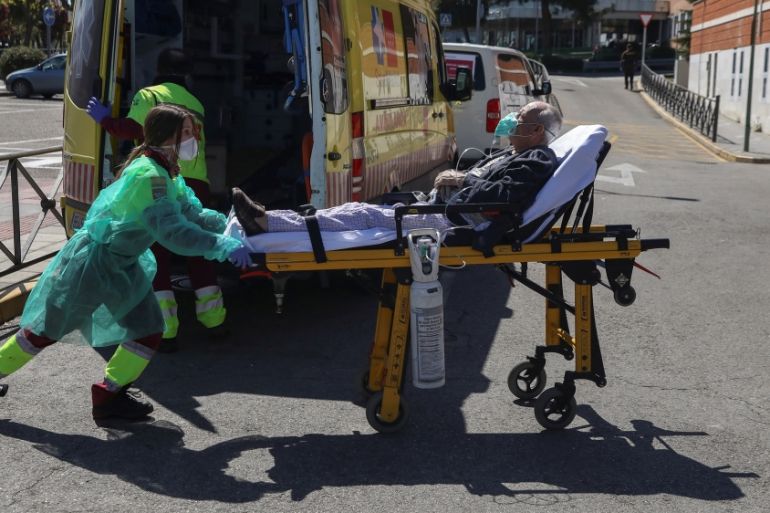COVID-19 deaths in Spain rise above 10,000: Five key developments
Spain has the world’s second-highest number of fatalities and rising unemployment, but there is hope amid the crisis.

A record 950 people have died from coronavirus in Spain in the space of 24 hours, lifting the country’s death toll to 10,003 from 9,053.
Meanwhile, the number of infections on Thursday rose to 110,238, up from 102,136 a day earlier.
Keep reading
list of 3 itemsExclusive: Inside a hospital battling coronavirus in Spain
As Spain records deadliest day, coronavirus lockdown stirs unrest
With the world’s second-highest number of fatalities after Italy, and third-highest tally of cases after the United States and Italy, Spain is struggling to contain the infection amid a strict lockdown that was recently extended until at least April 11.
Here are five key developments:
Despite tragic milestone, a ‘glimpse of hope’
Thursday’s increase in infections represented a 7.9 percent increase.
The daily increase in infections in percentage terms has been slowing gradually since March 25, when reported cases rose by just more than 20 percent.
Although the mounting death toll brought more grief to the Spanish people, Health Minister Salvador Illa insisted there was a reason for optimism.
“The data shows that the curve has stabilised – we have reached the highest point and things are slowing down,” he told parliament. “There’s light at the end of the tunnel. A glimpse of hope: the curve has stabilised.
“The peak of the curve and we have started the slowdown phase.”
Spain ‘practically paralysed’ as about one million people lose jobs
Spain, a country of about 47 million people, has shed an unprecedented 900,000 jobs since it went into lockdown in mid-March, with temporary layoffs affecting at least a further 620,000.
Social security data also showed that about 80,000 workers are off sick with coronavirus, while another 170,000 are on sick leave because they are isolated after coming into contact with someone with the virus.
Labour Minister Yolanda Diaz told reporters: “This is an absolutely unprecedented situation.”

Spain has suffered from chronically high joblessness in its recent past, not least in the aftermath of the 2008-09 financial crisis when the unemployment rate rose to just below 27 percent.
“The country is practically paralysed as a result of the health emergency,” Unai Sordo, the leader of Spain‘s biggest labour union CCOO, told broadcaster TVE.
March is usually a good month for employment in Spain because it marks the start of the holiday season, with many temporary workers finding jobs, in particular in the hospitality sector.
“The destruction of jobs is extraordinarily heavy for women, young people and the most precarious work sectors,” Pepe Alvarez, leader of the UGT union, Spain‘s second-biggest union told RNE radio.
Medical staff use bin bags as aprons
Spain’s doctors and nurses have released clips of each other cutting up plastic garbage bags to use as protective clothing.
More than 15,000 of them are sick or self-isolating and unable to help patients – approximately 15 percent of the country’s confirmed cases.
In Spain we send our soldiers into combat with garbage bags… pic.twitter.com/nlZMDohjDu
— Ángel 🇪🇺🇪🇦 (@angeel_alg) April 1, 2020
One union has said the concentration is higher in the capital Madrid – 21 percent – the epicentre of the outbreak that has killed more than 9,000 and infected more than 100,000.
Medical workers in Italy, for example, make up just below 10 percent of reported COVID-19 cases, a smaller share than in Spain – although scientists say the data are not directly comparable because medical staff may not be tested at the same rate.
Man, 93, recovers from COVID-19
On Wednesday, doctors and medical staff applauded the discharge of a 93-year-old Spanish man who had recovered from COVID-19.
The man, whose name was not released, had spent five days in isolation at a hospital in La Seu d’Urgeil.
More than 95 percent of people who have died of coronavirus in Europe have been older than 60, the WHO said on Thursday.
Hospital staff cheers as 93-year-old man in Spain is discharged after COVID-19 recovery pic.twitter.com/mToAwIBbrp
— TIME (@TIME) April 2, 2020
For most people, the new coronavirus causes mild or moderate symptoms, such as fever and cough that clear up in two to three weeks.
For some, especially older adults and people with existing health problems, it can cause more severe illness, including pneumonia, and can lead to death.
In about-turn, Catalonia seeks Spanish military help
The separatist government of Spain’s Catalonia region abandoned its initial reluctance and asked the national military on Thursday for assistance in tackling the coronavirus pandemic.
Catalonia is a badly hit region with more than 2,000 deaths and about 2,000 people in intensive care.

Last month, an official of the Catalonia government, whose independence quest has created political turmoil in recent years, said military help was “totally unnecessary”.
However, Alba Verges, a senior health official in the northeastern region, told Catalunya Radio that assistance from military health personnel would now be welcome.
“We need hands. Hands also means that if [the military] has doctors and nurses that they make them available to us,” she said.